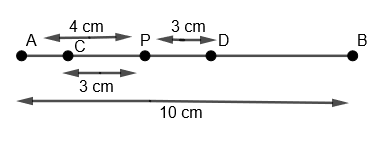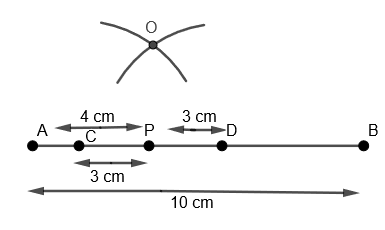
Draw a line segment AB of length 10 cm. Mark a point P on AB such that AP = 4 cm. Draw a line through P perpendicular to AB.
Answer
526.8k+ views
Hint: First of all, draw a line AB = 10 cm and mark point P such that AP = 4 cm. Now mark two points on both sides of P on line AB equidistant from P. Now with the centers at these points, draw an arc above line AB and proceed to get the required perpendicular.
Complete step-by-step answer:
Here, we have to draw a line segment AB of length 10 cm. Then, we have to mark a point P on AB such that AP = 4 cm. Finally, we have to draw a line through P which would be perpendicular to AB.
(i) Let us first draw the line AB = 10 cm with the help of a ruler as follows:

(ii) Now, with A as the center and 4 cm as the radius, we will draw an arc on AB as

(iii) We will name this point as P such that AP = 4 cm.

(iv) Now, we will take any radius, say 3 cm. With P as center and radius = 3 cm. We will draw an arc on the left side of P on line AB as,

(v) We will name this as point C.

(vi) Now with the same radius that is 3 cm and with P as the center, we will again draw an arc on the right side of P on the line AB as,

(vii) We will name this as point D.

(viii) Now with D as center and radius greater than DP, we will draw an arc above line AB as,

(ix) Now with C as the center and with the same radius as that of the previous step, we will draw an arc cutting the previous arc and we will name this point of intersection of two arcs as O.

(x) Now we will join OP and extend it.

Hence, we get OP as the required perpendicular on line AB through P.
Note: Some students make this mistake of constructing the perpendicular bisector of AB but they must keep in mind that they have to construct perpendicular passing through P. Also, students can cross-check their construction by measuring if angle
Complete step-by-step answer:
Here, we have to draw a line segment AB of length 10 cm. Then, we have to mark a point P on AB such that AP = 4 cm. Finally, we have to draw a line through P which would be perpendicular to AB.
(i) Let us first draw the line AB = 10 cm with the help of a ruler as follows:

(ii) Now, with A as the center and 4 cm as the radius, we will draw an arc on AB as

(iii) We will name this point as P such that AP = 4 cm.

(iv) Now, we will take any radius, say 3 cm. With P as center and radius = 3 cm. We will draw an arc on the left side of P on line AB as,

(v) We will name this as point C.

(vi) Now with the same radius that is 3 cm and with P as the center, we will again draw an arc on the right side of P on the line AB as,

(vii) We will name this as point D.

(viii) Now with D as center and radius greater than DP, we will draw an arc above line AB as,

(ix) Now with C as the center and with the same radius as that of the previous step, we will draw an arc cutting the previous arc and we will name this point of intersection of two arcs as O.

(x) Now we will join OP and extend it.

Hence, we get OP as the required perpendicular on line AB through P.
Note: Some students make this mistake of constructing the perpendicular bisector of AB but they must keep in mind that they have to construct perpendicular passing through P. Also, students can cross-check their construction by measuring if angle
Recently Updated Pages
Master Class 9 General Knowledge: Engaging Questions & Answers for Success

Master Class 9 English: Engaging Questions & Answers for Success

Master Class 9 Science: Engaging Questions & Answers for Success

Master Class 9 Social Science: Engaging Questions & Answers for Success

Master Class 9 Maths: Engaging Questions & Answers for Success

Class 9 Question and Answer - Your Ultimate Solutions Guide

Trending doubts
Fill the blanks with the suitable prepositions 1 The class 9 english CBSE

Difference Between Plant Cell and Animal Cell

Given that HCF 306 657 9 find the LCM 306 657 class 9 maths CBSE

The highest mountain peak in India is A Kanchenjunga class 9 social science CBSE

What is the difference between Atleast and Atmost in class 9 maths CBSE

What was the capital of the king Kharavela of Kalinga class 9 social science CBSE




